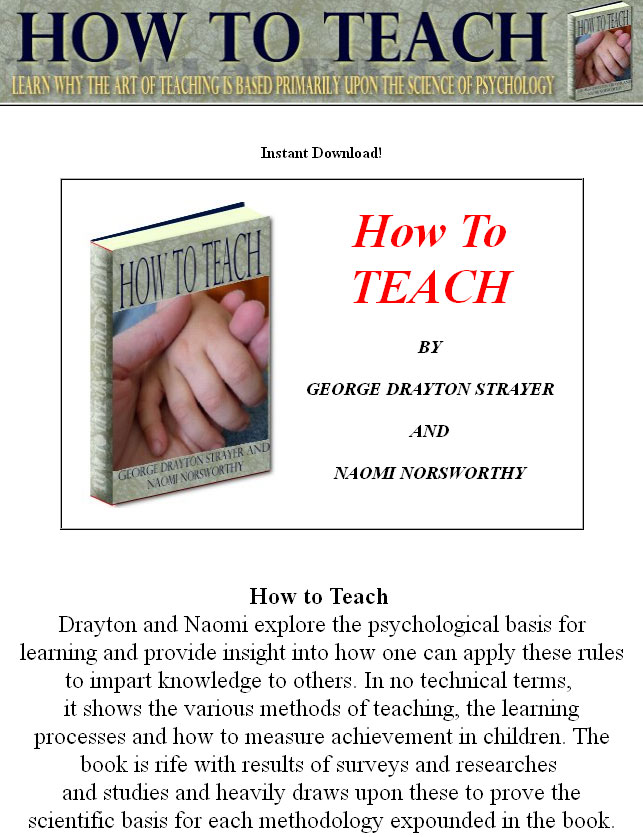Salespage Snapshot:

Table of Contents
I. THE WORK OF THE TEACHER
II. ORIGINAL NATURE, THE
CAPITAL WITH WHICH TEACHERS
WORK
III. ATTENTION AND INTEREST IN
TEACHING
IV. THE FORMATION OF HABITS
V. HOW TO MEMORIZE
VI. THE TEACHER’S USE OF THE
IMAGINATION
VII. HOW THINKING MAY BE
STIMULATED
VIII. APPRECIATION, AN
IMPORTANT ELEMENT IN
EDUCATION
IX. THE MEANING OF PLAY IN
EDUCATION
X. THE SIGNIFICANCE OF
INDIVIDUAL DIFFERENCES FOR
THE TEACHER
XI. THE DEVELOPMENT OF MORAL
SOCIAL CONDUCT
XII. TRANSFER OF TRAINING
XIII. TYPES OF CLASSROOM
EXERCISES
XIV. HOW TO STUDY
XV. MEASURING THE
ACHIEVEMENTS OF CHILDREN
Sample Content Preview
I. THE WORK OF THE TEACHER
Education is a group enterprise. We establish schools in which we seek to develop whatever capacities or abilities the individual may possess in order that he may become intelligently active for the common good. Schools do not exist primarily for the individual, but, rather, for the group of which he is a member. Individual growth and development are significant in terms of their meaning for the welfare of the whole group. We believe that the greatest opportunity for the individual, as well as his greatest satisfaction, are secured only when he works with others for the common welfare. In the discussions which follow we are concerned not simply with the individual’s development, but also with the necessity for inhibitions. There are traits or activities which develop normally, but which are from the social point of view undesirable. It is quite as much the work of the teacher to know how to provide for the inhibition of the type of activity which is socially undesirable, or how to substitute for such reactions other forms of expression which are worthy, as it is to stimulate those types of activity which promise a contribution to the common good. It is assumed that the aim of education can be expressed most satisfactorily in terms of social efficiency.
An acceptance of the aim of education stated in terms of social efficiency leads us to discard other statements of aim which have been more or less current. Chief among these aims, or statements of aim, are the following: (1) culture; (2) the harmonious development of the capacities or abilities of the individual; (3) preparing an individual to make a living; (4) knowledge. We will examine these aims briefly before discussing at length the implications of the social aim.
Those who declare that it is the aim of education to develop men and women of culture vary in the content which they give to the term culture. It is conceivable that the person of culture is one who, by virtue of his education, has come to understand and appreciate the many aspects of the social environment in which he lives; that he is a man of intelligence, essentially reasonable; and that he is willing and able to devote himself to the common good. It is to be feared, however, that the term culture, as commonly used, is interpreted much more narrowly. For many people culture is synonymous with knowledge or information, and is not interpreted to involve preparation for active participation in the work of the
Other Details- 3 Ebooks (DOC), 85 Pages
- 1 Salespage (HTML)
- Year Released/Circulated: 2009
- File Size: 459 KB
License Details:
[YES] Include Professional Sales Letter.
[YES] Can edit the sales letter and graphics.
[YES] Can sell Master Resale Rights.
[YES] Includes Professional Graphics.
[YES] Can Put Your Name As The Author.
[YES] Can Be Edited.
[YES] Can Be Used As Web or e-zine content
[YES] Can be added into a paid membership sites.
[YES] Can Be Broken Down Into Articles.
[YES] Can Sell Private Label Rights.
[NO] Can be offered as a bonus.
[NO] Can be given away for free.
[NO] Can be offered through on any auction sites.
[NO] Can be added to a free membership.











